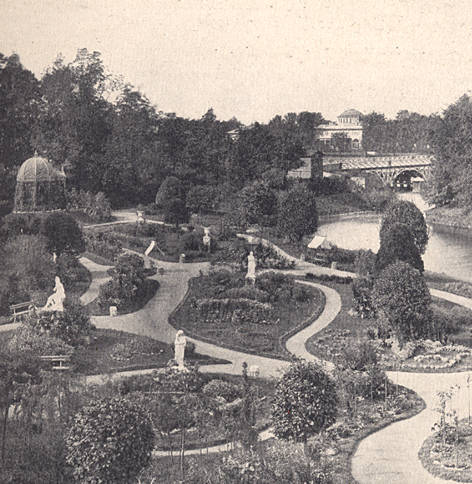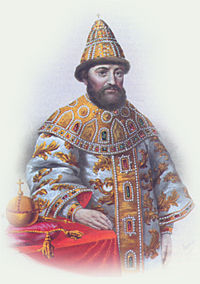   

How many American tourists in 1900 were astute enough to foresee that in a few short years the people who lived in these villas and gardens and the very society they lived in would be swept away? How aware were visiting foreigners of the tensions between the classes? Looking back through the history of the last 100 years it's hard for us to imagine how the inequities in Russia wouldn't have been one of the chief things Americans noticed.
Many people today have the notion that the nobility was a very small class in Russia. In proportion to the rest of the population this is true, but in Petersburg in 1900 there were 80,000 nobles by birth and 150,000 other people who held noble rank due to their contribution to society. A noble rank did not necessarily mean wealth, in fact some of the nobility were just a step above their poor brothers and sisters of the working classes. It often surprizes people to know that Lenin himself came from the ranks of the lower nobility.  Above: Ball in the Hall of the Nobility in Petersburg.
The Russian system of nobility was based on the Chinese "chin" system with various levels and ranks. A person's position in society was clearly defined by his rank. In Russia some titles - such as Prince and Princess - had direct slavonic equivalents and were as hold as Russia itself. Some families holding these titles had better pedigrees than the Romanovs themselves. Other titles - such as Count and Baron were imported from Western Europe and were freely distributed from the Tsars - from Peter the Great onwards - to noteworthy Russians and foreigners.
 The title of Grand Duke and its feminine form, Grand Duchess, designated the direct descendants of a reigning Tsar or Tsarina. In the reign of Alexander III there were so many Romanovs that the Emperor decided to limit this title - and its generous yearly grant from his coffers - to only the sons, daughters, grandsons and granddaughters of a Tsar. The title of Grand Duke and its feminine form, Grand Duchess, designated the direct descendants of a reigning Tsar or Tsarina. In the reign of Alexander III there were so many Romanovs that the Emperor decided to limit this title - and its generous yearly grant from his coffers - to only the sons, daughters, grandsons and granddaughters of a Tsar.
The house of Romanov assumed the throne in 1613, when it was offered to Mikhail Romanov by a delegation from an assembly of the Russian people. In 1913 the dynasty celebrated 300 years of Romanov rule. Virtually the entire Imperial family made an extensive tour of the sites associated with the events of 1613, including the Ipatiev Monastery in Kostroma, where Mikhail Romanov received the crown. This tour was successful or unsuccessful depending on the political views of the person asked. Hundreds of thousands of people participated in the celebration and it took on aspects of a religious pilgrimage for some. In hindsight historians see the "Tecentenary" as the swan song of the dynasty. In any event it was the last great event of national rejoicing before WWI and the revolution ended Old Russia once and for ever.
Herr Jerrman explains the system of ranks as he saw it in 1855:
"Although the Russian, great or small, lofty or humble, is before his Czar (like we other mortals before God), neither more or Iess than nothing, yet these nonentities have a political classification, and are duly divided into nobles, burghers, and peasants. The nobles are free, that is to say, as free as any one can be in Russia; tho noblest cannot marry according to his heart's choice, if that choice does not chime in with the Czar's good pleasure; or, if he desires to go
to Italy, and the Czar strikes out the word "Naples" on his passport and inserts 'Tobolsk" the horses, against their master's will gallop eastward instead of south-west - such is the instinct of Russian horses. Or if by chance he desires to serve in the cavalry of the guard, and the Czar sends him aboard a sloop of war, he sails upon the ocean instead of riding on horseback, and does so without a word of objection or complaint, because it is the Master's will.
Such things happen very rarely; but they may happen, and when they do, they happen de-jure as well as de-facto, for the Czar's will is the Russian's law...
To return, however, to our classification. Next to that source of all power and greatness, the Court, stands the nobility, which is divided into two classes - the aristocracy of birth, and the aristocracy of service or government employment. The possessor of the first mentioned sort brings it with him into the world, and retains it until death - always supposing some gracious decree does not intervene to send him off to the Caucasus, shorn alike of hair and aristocracy. This, however, happens only as a punishment for a crime; and even in this condemnation to service as a private soldier there is a certain degree of mercy; for in the ranks of the army, and under fire of the enemy, the degraded nobleman has opportunity of regaining rank and title.
The second order of nobility, the official aristocracy, is within reach of any one who aspires to it - if he only live long enough. On entering the public service he takes his place in Class Fourteen. That is just a little more than nothing at all, and usually elicits a deep sigh from the person who confesses himself to belong to that class, and a compassionate smile from him to whom the confession is made. Promotion, however, is pretty rapid; and as, if I do not mistake, nobility is attained with the eighth class, which point even the dullest cannot fail to reach, even by mere progressive seniority, so the candidate, if he lives, is sure of attaining his object. The higher classes confer a military grade, from lieutenant up to general. A counsellor of state, for instance, has lieutenant-general's rank; a state counsellor of the first order a general's rank, with the title of Excellency. The hereditary nobles begin at once with the rank of major; which must, however, be earned over again by service to the state; for in social position and estimation the official aristocracy stand far higher than the hereditary; and a high-born count of a low official class, feels himself very small beside a plebeian who has outstripped him in official rank. This arrangement is wise and just, and does much to compensate the tyranny of birth, whose aristocratic exclusiveness it overthrows; procuring at the same time due consideration and esteem for the only true nobility - the nobility of good conduct and useful services.
Immediately after this official nobility comes the commonalty, or class of burgesses, a free class, consisting chiefly of traders. In this class, also, there are gradations. Highest upon the ladder stand the merchants of the "first guild," the aristocracy of capital and industry. The middle station is occupied by merchants of the second guild, whose commerce has narrower limits; whilst on the lowest range, next the ground, are found traders of the third guild, - petty dealers, who have not even, I believe, the right of drawing bills of exchange. The commercial aristocracy of the first guild, which enjoys the privileges of the nobility, imitates it in many respects - drives four horses, keeps a sumptuous house, inhabits beautiful villas, and in every possible way, and in emulation of the great nobles, strives to ruin itself, - with less success, however, than those it apes, since the inexhaustible fountains of trade constantly refill the empty coffers. One can hardly form an idea in Germany of the vast wealth of some of these Russian merchants. Stieglitz, one of the richest bankers in Russia, left behind him, at his death, a fortune of 40,000,000 of rubles banco, besides a great deal of land. And, yet there is no dearth in Russia of people richer than he was."
Next photograph: The Imperial Mariinsky Theatre
For a small map of the St. Petersburg area click here.
To see a large map of the center
of St. Petersburg go here.
Comments on the website should be sent to Bob
Atchison. |
 |
|

